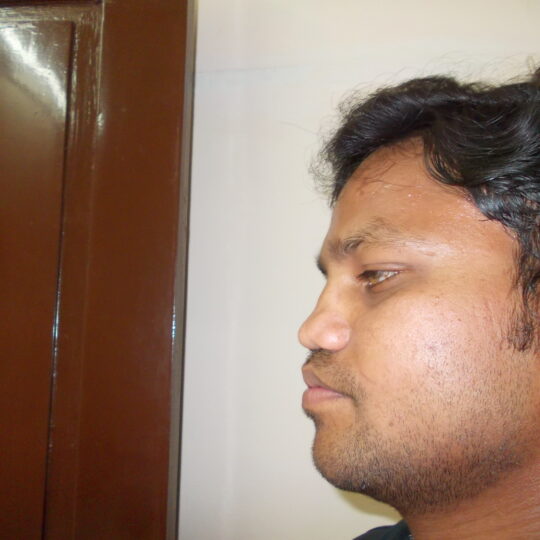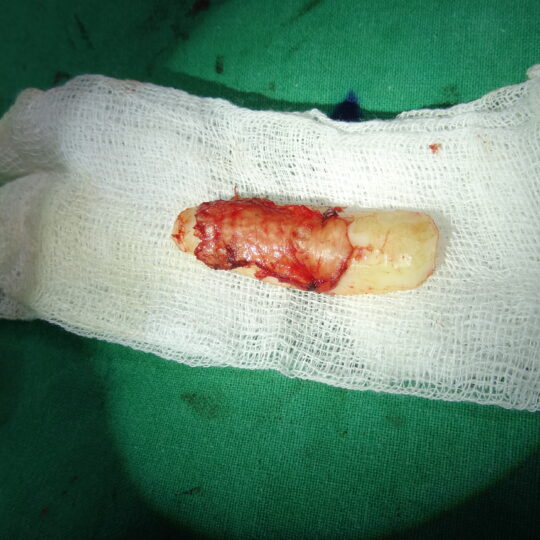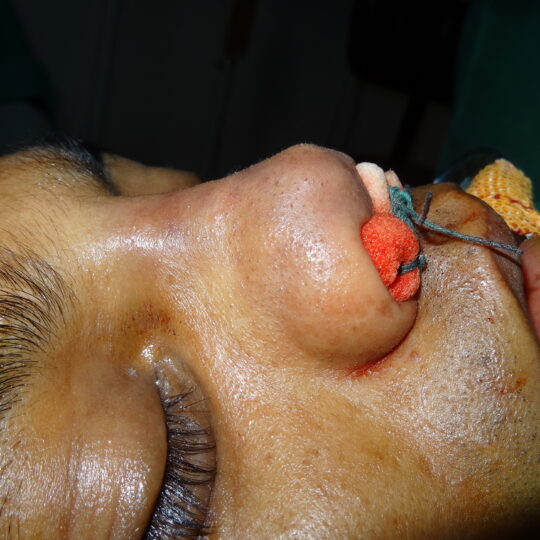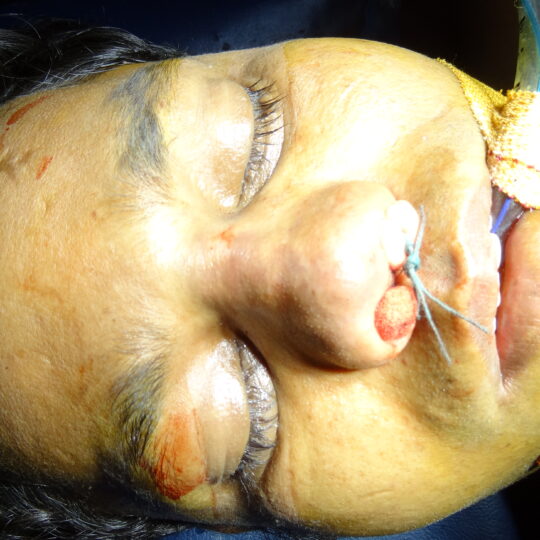Nasal Deformity Rhinoplasty
What gives the nose its shape?
The shape of the nose on the outside is due to the shape of bone and cartilage and the overlying skin. The top of the nose is made of bone shaped like a roof, which is hard. The middle and tip of the nose are made of cartilage which is softer. The skin varies in thickness from person to person, and also affects the shape.
Reasons for surgery
Improving the features of the nose and face by cosmetic surgery can also involve improving its function and help with breathing. There is a great deal of variety in human appearance. Nasal shape depends on the bony contours, dimensions of the face, skin colour, thickness and race. Most people have reconciled themselves with their appearance but some are unhappy with it and seek surgery. The most common features people are concerned with are deviations of the nose to one side, a nasal hump, a nasal depression, too wide or too narrow a nose, over or under projection of the soft nasal tip. There is no perfect shape to the nose and any alteration has to fit and suit the rest of the face. It is important that expectations about the effects of surgery are not unrealistic. People who believe that their lives will change if they have cosmetic surgery are often disappointed.
What is rhinoplasty?
Rhinoplasty is an operation to change the shape of the nose. The type of rhinoplasty depends on which particular area of the nose needs correction. The nose can be straightened, made smaller or bigger and bumps may be removed. The shape of the tip of the nose can be changed. Pieces of cartilage or bone may be removed from or added to the nose to change its shape. Sometimes the wall that separates the nose into right and left (nasal septum) is twisted. We may need to correct it at the same time. The combined operation is called septorhinoplasty.
Techniques Rhinoplasty
surgery employs reduction, augmentation or refinement of the patient’s nose to give a balanced and proportioned nose. Reduction rhinoplasty commonly involves the removal of a nasal hump along with re-breaking the nose to reduce the width. The tip of the nose may be asymmetrical, depressed or the nose itself may need building up. Augmentation can be achieved using tissue moved from another part of the patient’s body such as skin or cartilage from the ear or rib. Alternatively synthetic material can be used (gortex, silastic) but there is a greater risk of rejection or infection. Approaches for the surgery can be either through the nostrils (intranasal) or by the use of a small incision on the underside of the nose (external).
How successful is the operation?
Everybody’s nose and face is different, so it may not be possible to make your nose look exactly like your perfect nose. The thickness of the skin is important in how much better the nose will look after rhinoplasty and in what can be done. If the skin is thin, it makes bumps or hollows in the nose difficult to hide. If it is thick not all changes that can be made on the inside will show up on the outside. Your surgeon will aim to produce a nose that looks natural. However, your surgeon may not be able to say exactly how your nose will look after your operation. It is important that you discuss your expectations with your surgeon. 80 % of patients are happy with the results of their operation but some people request more surgery. You may change your mind about the operation at any time, and signing a consent form does not mean that you have to have the operation. If you would like to have a second opinion about the treatment, you can ask your specialist. He or she will not mind arranging this for you. You may wish to ask your own GP to arrange a second opinion with another specialist.
How is the operation done?
Rhinoplasty and septorhinoplasty are usually performed with you asleep. Cuts are made inside your nose. Occasionally a small cut on the skin between the nostrils or at the base of the nostrils may be necessary. The skin of your nose is gently lifted off the bone and cartilage underneath. A hairline fracture may be made in the nasal bones to allow the surgeon to change the shape of the nose. Pieces of bone and cartilage can be removed from or added to the nose to smooth out any bumps or dips.
Packs and splints
We may need to put a dressing in each side of your nose to keep things in place and prevent bleeding. The dressings are called ‘packs’, and they will block your nose up so that you have to breathe through your mouth. We may take them out the morning after your operation. You may get a little bit of bleeding when the packs come out – this will settle quickly. Sometimes we put small pieces of plastic in your nose to prevent scar tissue from forming. These are called ‘splints’ and we will take them out after a week. You will have a temporary splint on the outside of the nose for a week. This should be kept dry.
After the operation
The front of your nose can be a bit tender for a few weeks. Do not blow your nose for about a week, or it might start bleeding. If you are going to sneeze, sneeze with your mouth open to protect your nose. You may get some blood-coloured watery fluid from your nose for the first two weeks or so – this is normal. Your nose will be blocked both sides like a heavy cold for 10-14 days after the operation. We may give you some drops or spray to help this. It may take up to three months for your nose to settle down and for your breathing to be clear again. Try to stay away from dusty or smoky places. There will be some stitches inside your nose – these will dissolve and fall out by themselves. You may have some bruising and swelling around your nose and eyes for one to two weeks. Sleeping upright with extra pillows for a few days helps. Most of the swelling has subsided after two weeks but it may be longer before the skin and soft tissues over the bone and cartilage settle. Fine swelling may take up to a year to settle at which time the final results of surgery may be judged. Following rhinoplasty or septorhinoplasty, the skin of the nose is very sensitive to the sun. It is important to wear strong sunscreen and a hat for at least six months. The nose may feel a little stiff and numb for up to three months, particularly around the tip.
How long will I be off work?
You can expect to go home the day after your operation. Sometimes it is possible to go home the same day. You should rest at home for at least a week. Most people need one to two weeks off work, especially if their work involves heavy lifting or strenuous activity. You should not play sports where there is a risk of your nose being knocked for six weeks. Ask your nurse if you need a sick note for your time in hospital.
What can go wrong?
Sometimes your nose can bleed after the operation, and we may have to put packs into your nose to stop it. This can happen within the first 6 – 8 hours after surgery or up to 5 – 10 days after surgery. Very occasionally patients need to have another general anaesthetic and return to the operating theatre to stop the bleeding. Infection in your nose is rare after this operation but if it happens it can be serious, so you should see a doctor if your nose is getting more and more blocked and sore. Very rarely, you can have some numbness of your teeth, which usually settles with time. Up to 10% of people may have some reservations about the end results and about 5-10% of patients need further operations in the future to further adjust the shape of the nose.

Contact us
Bayya Hospitals
12-25-192, Bhagath Singh Centre, Kothapet, Guntur, Andhra Pradesh 522001
0863-2225729
+91 6304429294
+91 93819 22827
Useful Links
Consultation Hours
For ENT
Monday – Saturday 9AM – 1:30 Noon,
Evening 5:30PM to 8:00PM
Sunday – CLOSED
For EYE
Monday – Saturday 9AM – 5:00PM
Sunday – CLOSED












